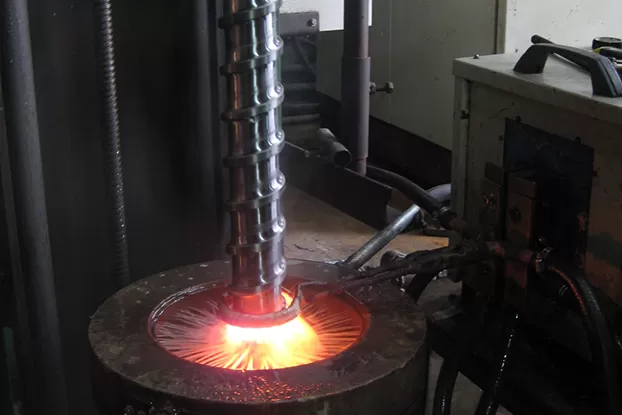+86 28 8393 0607
+86 28 8393 0607
Jun. 24, 2025
In the field of metal heat treatment, two commonly referenced processes are induction hardening and quenching. While both methods aim to improve the hardness and wear resistance of metal components, they differ significantly in principles, applications, and equipment. Understanding these differences is critical for selecting the right solution for your production needs.
Induction hardening is a surface heat treatment technique that uses electromagnetic induction to heat the surface of a metal component rapidly. A high-frequency alternating current passes through a copper coil, creating a magnetic field that induces eddy currents in the metal part, heating it to the desired hardening temperature. Once the heating is complete, the part is immediately quenched—usually with water or polymer—resulting in a hardened surface layer with a tough core.
Compared to traditional methods, induction hardening offers several advantages:
Precision and repeatability
Localized heating that minimizes thermal distortion
Faster cycle times and lower energy consumption
Automation compatibility for mass production

Duolin, a trusted manufacturer of induction hardening machines, has been providing tailored solutions for over 20 years. Their systems are widely used in automotive parts, agricultural machinery, mining tools, and other industrial applications where surface durability is essential.
Quenching is a more general term in metallurgy. It refers to the rapid cooling of metal—often steel—after it has been heated to a specific temperature. Unlike induction hardening, quenching typically follows a broader heating method such as furnace heating, where the entire part, not just the surface, is brought to temperature. Once the part reaches the desired phase, it is submerged in water, oil, or other quenching media to achieve hardness.
While quenching is essential for achieving desired microstructures and hardness levels, it can cause:
Greater internal stress due to overall temperature change
Risk of cracking or warping
Longer processing times due to batch heating and cooling
| Feature | Induction Hardening | Traditional Quenching |
|---|---|---|
| Heating Method | Electromagnetic induction (localized) | Furnace or torch (uniform or bulk heating) |
| Process Speed | Fast and targeted | Slower, especially for large batches |
| Energy Efficiency | High | Moderate to low |
| Distortion Risk | Low (localized heat) | High (entire component heated and cooled) |
| Best Use Case | Surface hardening of specific areas (e.g. shafts) | Through-hardening or bulk hardening |
The decision between induction hardening and traditional quenching depends on the component geometry, material type, desired hardness depth, and production volume. For industries seeking higher efficiency, precision, and minimal distortion, induction heating technology offers a forward-looking solution.
Duolin continues to lead innovation in custom induction heating equipment, offering support from design to commissioning to ensure optimal performance for your specific process requirements.
Latest News
Types of Induction Heating Machines
Oct. 27, 2025
Induction heating is a widely utilized process in various industries, offering efficient and precise heating solutions. The selection of an appropriate induction heating machine depends on factors such as the material to be heated, desired heating depth, and specific application requirements.
What Is the Difference Between Induction Heating and Electric Heating?
Oct. 13, 2025
Induction heating and electric heating are two distinct methods of generating heat, each with unique characteristics and applications. Understanding their differences is crucial for selecting the right technology for specific industrial processes.
Case Presentation
Customized Turnkey induction heating machine
Provide solution according to your requirement, well match with your production line
Related Products
100-300KW High Frequency Induction Heating Equipment
Power 30-300KW
Work Frequency 50-250Khz
This small power induction heater are high performance on small parts metal induction heating, easy to move and operate. Designed, produce and develpoment by Duolin team for 30 years, durable and good heating performance.
Induction heating is the process of heating an electrically conducting object (usually a metal) by electromagnetic induction, through heat generated in the object by eddy currents. An induction heater consists of induction power supply (induction heater) and inductor (coil) that is a shaped to contour the part, and a work station where the part is held and presented to the coil.
Quick Links
Tel.: +86 28 8393 0607
Mob.: +86 158 8242 2821
WhatsApp: +86 158 8242 2821
Add.: 112th Hancheng Road Xindu Industrial Zone Chengdu China




